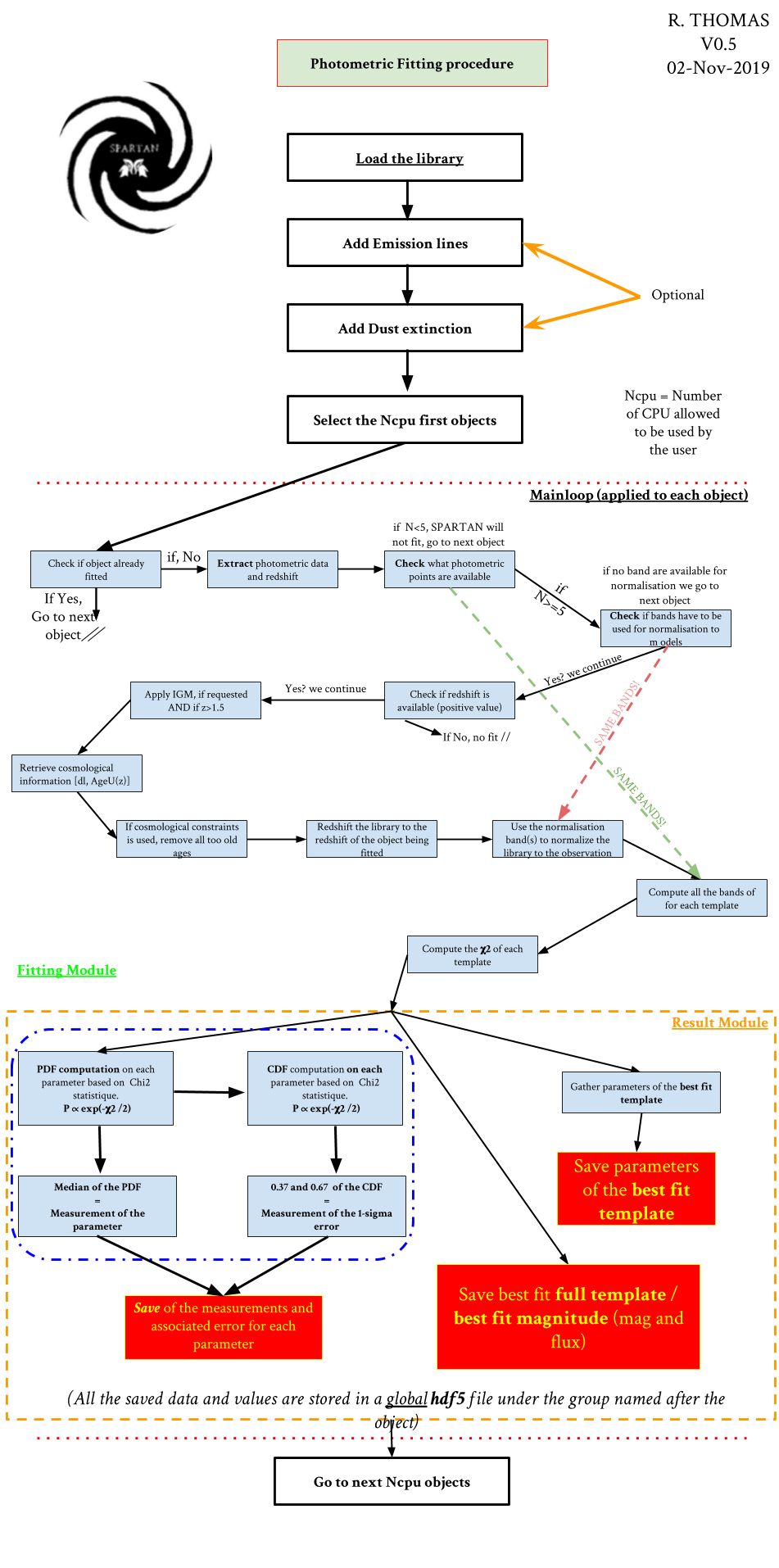Photometric fitting¶
Configuration¶
The catalog that you need to give to SPARTAN is an ascii file. When SPARTAN opens it, it will read the header. Whatever you want to fit the header of the catalog must start with two columns: ID and redshift with an hash(#) at the beginning of the line. THIS IS MANDATORY:
#ident redshift
Then you must add the columns with the following rules. When you want to fit multi wavelength photometry, you have to add as many 2 columns sets as you have photometric points. Therefore you will have (for 5 photometric points):
#ident redshift mag1 mag1_err mag2 mag2_err mag3 mag3_err mag4 mag4_err mag5 mag5_err
Magnitudes can be provided in AB or in Jy. The only constraints is to not mix up the different system in a given configuration (all AB or all Jy).
You can find an example of such file here Photometric input catalog
Fitting procedure: generalities¶
The flow chart shows the detailed procedure of the fit of a sample of single object. It is composed of 3 parts:
The initialization of the run where we load the library and the sample to fit.
The main loop. Where are actually making the fit
The results module where we save the results of a fit and where the final catalog of parameter is created
We describe in detail each parts below in the following paragraphs.
The Initialization¶
Here SPARTAN load the library that was computed from the configuration of the user. It loads both the table of parameters (and their names) and the table of templates. Everything is loaded from the .hdf5 library file. Then the code takes the _dat.hdf5 file that was created from the configuration and the catalog of data that was given. He will make a quick loop over the full sample to check if some objects were already fitted. If so they will be skipped (unless the user allow the overfit, c.f. configuration above and TUI.)
Warning
This first check is important. It means you can stop a fitting run at any moment and start it again from where you stopped, without needing to start all the run over from the beginning.
From the left over objects to plot, SPARTAN will take the firsts Ncpu (see TUI) object in the list and will send them to the fitting function. Each object will be fitted in parallel.
The main function¶
We discuss here the main loop that is applied to each obect.
The function starts by checking again if we should fit the object. In that case, SPARTAN extracts, from the _dat.hdf5 file, all the photometric infomation needed: measured magnitude with their error, corresponding filter passbands andnormalization informations (see next section), the redshift, etc…
After this first step, SPARTAN will apply the redshift to the library and add the emission lines to the library (if requested) and apply the attenuation by dust and extinction by the IGM. If the user request the use of a cosmological model, templates that are above the age of the Universe at the considered redshift will be discarded from the library. The template that remain in the library will be used to compute the chi2.
The result module¶
From the library of chi2, SPARTAN computes the PDF and the CDF for each parameter. This will give access to the parameter measurements and their errors. If the user ask for it, the parameters from the best fit template (therefore without error) can be saved as well (see below). Aditionnaly, SPARTAN saves the best fit template (both original and resampled templates).
Data/Template Normalization¶
The fit relies on the ability to normalize the galaxy models to the observations and number of parameters depends on this normalization (e.g. SFR, Mass). In the case of photometry, SPARTAN requires at least one normalization band in which the flux of the model will be matched to the one of photometry. The choice of the normalization is up to the user and can be chosen at the configuration stage (see Configuration of a fitting run at section ‘photometric configuration’). You need at least one band to normalize. You also have the ability to choose multiple bands. In that case, the normalization will be an average of the normalization on each band.
Results: Final catalog production and GUI vizualization¶
At the end of the fitting run, SPARTAN creates automatically the final catalog. Depending on what you asked for, it will contain:
The ID, redshift and number of points used during the fitting run.
The PDF parameters (measurement and errors, ex: PDF_SFR, m1s_SFR, p1s_SFR), if requested. You can also ask to save the complete PDF.
The Parameters from the best fit template (no errors in this case, ex: BF_SFR), if requested. The best fit model is also save so you can make a direct comparison between model and template. We also save the magitudes based on the best fit model.
After the fit you can also load the result file into the SPARTAN GUI. This will allow you to visualize the individual fits (see below). It can also show you the global result of your sample. Go to the Graphical User interface: Visualizing results GUI documentation for more information.







